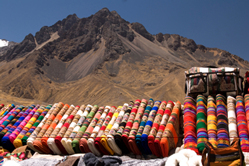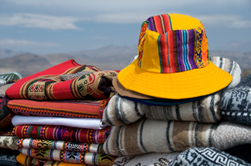PROCESS OF CREATING CLOTHING FROM ALPACA FIBER
Alpaca fleece makes luxurious clothes, but a lot has to be done to it before this can happen. The process of making clothes from Alpaca fiber and fleece is similar to making clothes from sheep wool and involves a number of different steps to which we will look at.
The first step towards fine alpaca garments is to shear the animal. Alpacas are shorn once a year, usually in Spring. This is more comfortable for the animals, because a thick coat of alpaca fleece is not the ideal thing to be wearing all summer! It also gives them time to grow a new coat before Winter returns. An alpaca is sheared in three stages. First the belly hair is cut. This is low quality and is usually thrown away. Next comes the "blanket." This is the back and sides of the animal's body and it gives the best fleece. Finally the legs and neck are sheared. This hair is coarser than the blanket, so it's usually kept separate and used for rugs. A single alpaca will give between five and eight pounds of usable fleece.
The sheared fleece is now sorted. As well as separating out blanket fleece from leg and neck hair, different colors are separated too. There are often multiple colors on the same alpaca, but it's easier to process a batch of fiber that's all the same color and it's best to sort it as soon as possible.
Once the fiber is sorted it needs to be cleaned. Alpacas live outdoors and their coats tend to pick up twigs, leaves and other plant debris, as well as dust and dirt that's blown into their fleece by the wind or picked up when they lie down. Debris can be picked or combed out of the fiber, and a wash in gentle detergent gets rid of the remaining dirt.
Now the clean and dry fleece needs to be carded. Carding is the process that turns raw fleece into a usable form, by passing it between moving surfaces covered in short pins. This loosens the fibers and unpicks any clumps or tangles, and pulls the fibers so they are parallel to each other. Finally the sheet of aligned fibers is drawn out into a thick rope. These can be twisted together to give a more consistent thickness.
The ropes produced by carding are the raw material of textiles, but to be used they have to be converted into yarn. This is done by spinning. Modern spinning machines strip fibers from the rope and blow them into a rotating drum. A strand of yarn is continuously pulled from the drum and as fibers are blown in they attach themselves to the end of it. The strand is then stretched and twisted, which strengthens it and brings it down to the required thickness. The spinning process can be used to produce either fine threads, suitable for sewing or weaving, or a thicker yarn suitable for knitting or crochet. Because alpaca is popular with small craftsmen and hobbyists it is also often spun by traditional methods, including distaffs and spinning wheels. This is a much slower process but can give a very high quality yarn.
Alpacas come in 22 recognized colors, and many alpaca products are used in these natural tones. There is also a demand for other colors though, which means dye has to be used. White alpaca is favored for this because it takes vivid colors very easily. Fiber is usually dyed once it has been spun. Traditional methods of dyeing are widely used in South America, using natural dyes like cochinilla. Alpaca has been dyed with these substances for thousands of years, and it's easy to see why!
With the yarn spun and dyed it's finally ready to be made into clothing. Fine yarn is woven into fabrics, which can then be cut and sewn into garments. Alpaca is also very popular for knitting and crochet, both for its own warmth, softness and quality and as a substitute for those allergic to sheep wool. Alpaca is non-allergenic, so is ideal for anyone who can't tolerate lanolin.
Many small artisan manufacturers carry out every one of these steps themselves, often using fleece from their own alpaca herd, resulting in truly hand-made garments. Turning an alpaca's coat into soft, luxurious garments is a long process, but the results are definitely worthwhile!



